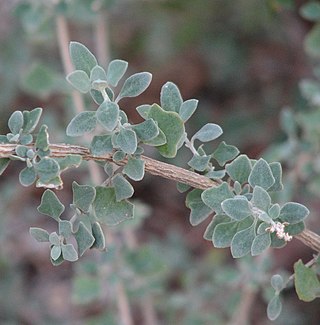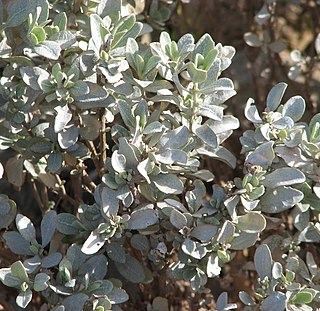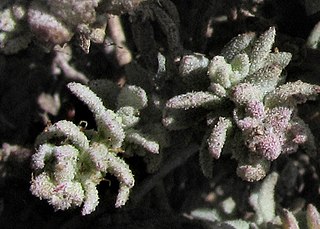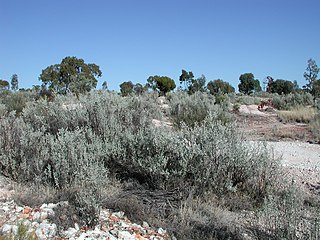
Atriplex is a plant genus of about 250 species, known by the common names of saltbush and orache. It belongs to the subfamily Chenopodioideae of the family Amaranthaceae s.l.. The genus is quite variable and widely distributed. It includes many desert and seashore plants and halophytes, as well as plants of moist environments. The generic name originated in Latin and was applied by Pliny the Elder to the edible oraches. The name saltbush derives from the fact that the plants retain salt in their leaves; they are able to grow in areas affected by soil salination.

A tumbleweed is a structural part of the above-ground anatomy of a number of species of plants. It is a diaspore that, once mature and dry, detaches from its root or stem and rolls due to the force of the wind. In most such species, the tumbleweed is in effect the entire plant apart from the root system, but in other plants, a hollow fruit or inflorescence might detach instead. Xerophyte tumbleweed species occur most commonly in steppe and arid ecosystems, where frequent wind and the open environment permit rolling without prohibitive obstruction.

Atriplex amnicola, commonly known as river saltbush or swamp saltbush, is a species of shrub in the family Amaranthaceae. Endemic to Western Australia, it is native to the floodplains of the Murchison and Gascoyne Rivers.

Atriplex cinerea, commonly known as grey saltbush, coast saltbush, barilla or truganini, is a plant species in the family Amaranthaceae. It occurs in sheltered coastal areas and around salt lakes in the Australian states of Western Australia, South Australia, Tasmania, Victoria and New South Wales.

Atriplex vesicaria, commonly known as bladder saltbush, is a species of flowering plant of the family Amaranthaceae and is endemic to arid and semi-arid inland regions of Australia. It is an upright or sprawling shrub with scaly leaves and separate male and female plants, the fruit often with a bladder-like appendage.

Atriplex patula is a ruderal, circumboreal species of annual herbaceous plant in the genus Atriplex naturalized in many temperate regions.

Enchylaena tomentosa, commonly known as barrier saltbush or ruby saltbush, is a small native shrub of Australia.

Salicornia quinqueflora, synonym Sarcocornia quinqueflora, commonly known as beaded samphire, bead weed, beaded glasswort or glasswort, is a species of succulent halophytic coastal shrub. It occurs in wetter coastal areas of Australia and New Zealand.

Extriplex californica is a plant species known by the common name California saltbush or California orache. Formerly, it was included in genus Atriplex. It is native to coastal California and Baja California, where it grows in areas with saline soils, such as beaches and salt marshes.

Atriplex nummularia is a species of saltbush from the family Amaranthaceae and is a large woody shrub known commonly as oldman saltbush. A. nummularia is native to Australia and occurs in each of the mainland states, thriving in arid and semi-arid inland regions.

Extriplex is a plant genus in the subfamily Chenopodioideae of the family Amaranthaceae. It has been described in 2010 and comprises two species, that were formerly included in genus Atriplex. They are restricted to the California Floristic Province.

Stutzia is a plant genus in the subfamily Chenopodioideae of the family Amaranthaceae. It was described in 2010, replacing the illegitimate name Endolepis. It comprises two species, that have also been included in the genus Atriplex.

Caroxylon vermiculatum, commonly known as Mediterranean saltwort, is a perennial plant in the family Amaranthaceae. It has many synonyms, including Salsola vermiculata and Nitrosalsola vermiculata. It is native to arid and semi-arid regions of the Middle East, North Africa and southern Europe where it is used as a fodder plant for livestock.

Dissocarpus paradoxus is a shrub species of inland Australia, also known by the common names of cannonball burr or curious saltbush.

Atriplex holocarpa is a low-growing species of Atriplex (saltbush) found throughout arid regions of Australia. A. holocarpa is commonly known as pop saltbush, because its carpals pop when stepped upon.

Atriplex stipitata, commonly known as mallee saltbush, bitter saltbush and kidney saltbush, is a species of shrub in the family Amaranthaceae, found in all mainland states of Australia.
Salsola melitensis is an endemic vascular plant of the Maltese archipelago. Its generic name is derived from the Latin word “salsus” which means salty, attributing to the salt tolerant nature of the species within this genus. The genus name was published in 1753 in the Species Plantarum composed by Carl Linnaeus but was reclassified again by Akhani et al. in 2007.

Atriplex sturtii, commonly known as saltbush, is an endangered species within the widespread genus Atriplex.A. sturtii is a native Australian shrub and grows in the Channel Country bioregion, also referred to as 'Corner Country'.

Atriplex angulata, commonly known as fan saltbush or angular saltbush, is a species of flowering plant in the family Amaranthaceae. It is an annual to short-lived perennial subshrub, native to Australia, distributed throughout drier parts of the mainland.
Atriplex nessorhina, the Donald Duck saltbush, is a species of flowering plant in the family Amaranthaceae, native to central South Australia, New South Wales, and southwest Queensland. Its bracteoles have swollen bases and beak-like valves.























